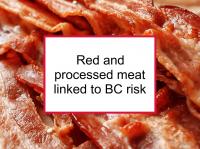High intakes of red meat and processed meat have both been linked to increased risk of breast cancer, especially hormone receptor positive (ER+/PR+) disease, although not all studies are in agreement. The increased risk appears to be derived primarily from the saturated fat and heterocyclic amine (HCA) contents of meat.
Intake of saturated fat has been linked to increased breast density, a powerful risk factor for breast cancer and recurrence. Red meat increases inflammation, another breast cancer risk factor. Consumption of saturated fat is also associated with reduced survival after a diagnosis of breast cancer. Now a new meta-analysis of prospective studies has provided confirmation that consumption of red meat and processed meat both are associated with increased breast cancer risk.
Breast cancer-promoting effects of red meat
Well-done red meat
The association between breast cancer and meat is strongest for consumption of well-done or fried meat (including hamburgers, bacon, pork chops, ribs and other fried or barbecued pork or beef). The association between breast cancer and well-done meat is strongest for red meat, but is also evident for chicken and fish. The heightened breast cancer risk appears to be a result of HCAs produced during cooking, especially cooking methods using high temperatures. One study reported that a common HCA (PhIP) appears to promote cancer in a manner similar to estrogen.
Saturated fat
Intake of saturated fat appears to be associated with breast cancer risk. In particular, high intake of the saturated fats palmitic acid (palm oil, red meat, butter, lard), margaric acid (beef, lamb, high-fat dairy), and stearic acid (red meat, lard, butter) have been shown to confer significantly high risk. High consumption of saturated fat is also associated with increased breast density.
Estrogen in beef
U.S. beef contains relatively high levels of estrogen compared to beef produced in other developed nations. One study reported that concentrations of 17β-estradiol(E2) and estrone (E1) were significantly higher in beef produced in the U.S. compared to Japan or Brazil. Estrogen levels are higher in fat than in muscle meat. The sources of estrogen in beef include soy-based feed and the use of growth promoters such as zeranol that are routinely administered to U.S. cattle.
Latest research links red meat and processed meat to increased risk
The meta-analysis of previous studies referenced at the beginning of this news story was designed to investigate the associations between red and processed meat consumption and breast cancer risk. The study was designed, in part, to address the fact that studies to date have yielded inconsistent results. To conduct the study, the authors combined data from relevant prospective studies. The studies were identified by searching the PubMed database through October, 2014, and by reviewing the references listed in retrieved articles. A total of 14 prospective studies concerning red meat (including 31,552 breast cancer cases) and 12 prospective studies on processed meat were included.
The risk of breast cancer was found to be 10% higher for the highest compared to the lowest levels of red meat consumption and 8% higher for processed meat. The risk was estimated to increase 11% for every 120 g (4.2 oz.) per day increase in consumption of red meat, and 9% for every increase of 50 g (1.8 oz.) per day of processed meat. The authors conclude that increased intakes of red and processed meat are associated with increased breast cancer risk. Further research with well-designed cohort or interventional studies is required to confirm the association, according to the authors.
